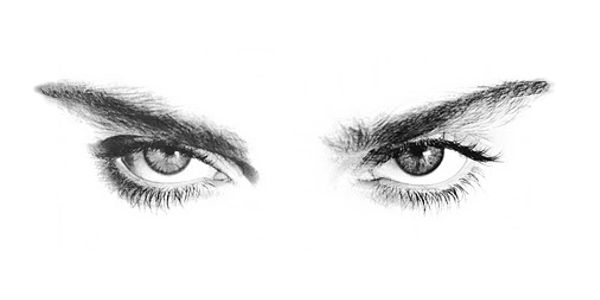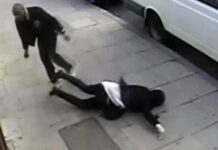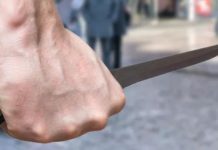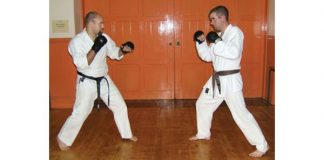Knowing where to look when standing face-to-face with a hostile subject is critical, though it’s rarely addressed in training. This is a glaring omission because knowing how to use your eyes the right way can save you embarrassment, prevent your subject from running away and, most importantly, it can save you from getting your nose shoved over a couple inches.
Before we proceed with where and how you should to look, it’s important that you keep this in mind: “Face-to-face,” does not mean nose-to-nose. Always maintain a safe distance, at least a little more than arm’s reach, from every person you talk with, whether it’s an elderly lady complaining about a barking dog, or a biker with tattoos on his face.
In this country it’s customary to look into the eyes of the person you are talking with, because to do otherwise, you may be thought of as sneaky or dishonest. But when confronting a hostile subject, someone right on the verge of exploding, or at least running off, focusing on his eyes may prevent you from recognizing certain telegraphic signals that he is about to spring.
There is a better place to look. It’s socially acceptable and it provides you with advanced notice of a hostile subject’s intention: It’s called the triangle
The Triangle
Look at yourself in a mirror and imagine two lines running from the point of your chin to the edge of each shoulder and then a single line stretching from one shoulder to the other. These three lines form a triangle over that place you want to look at frequently when you talk to a hostile subject. What makes the triangle so important is that any movement within it communicates to you that the subject is on the verge of taking some kind of action.
Check it out in the mirror. Cock your fist back and see what your shoulders do within the triangle. Lift any foot an inch or two and again see what happens with your shoulders. Pretend that you are going to run off to your right and watch what goes on within your triangle. Whatever movement you make, you can see it happen in that space. Even a highly trained boxer and martial artist signals with his shoulders as he begins to move in some fashion.
Does this mean you should just stare at the subject’s shoulders and chin area during your entire contact? No, that would look a little odd. Instead, move your eyes back and forth from his eyes to his triangle and then back to his eyes again. Even when you are looking at his eyes, use your peripheral to monitor movement within his triangle. This is important because that movement is telling you something.
How To Read The Triangle
Here are a few possibilities the subject might do when he moves in a particular way.
- When his shoulders and chest rotate counterclockwise a little, he is probably going to launch a right punch to your upper body or head.
- When his chest rotates counterclockwise and his shoulders dip forward, he is probably going to deliver a right-hand technique to your midsection.
- When his chest rotates either way with very little shoulder movement, he can punch with either hand.
- When his shoulder angles backward and his chest rotates counterclockwise, look for a right kick.
- When his chest rotates clockwise and his shoulders angle back, look for a left kick.
- If his upper body suddenly lifts, he is preparing to charge you with a push or tackle.
To reiterate, these movements are all detectable by looking at the triangle.
Watch His Breathing
Watching a subject’s breathing pattern is admittedly harder than looking for bold movement in his shoulder area, but with practice you will develop the ability to see it and detect when he is at his weakest. Watch the triangle to see the rhythm of his inhalation and exhalation.
An attack will most often occur during or right after the subject inhales, a moment when he is at his strongest. Expressing it another way, it’s difficult for an assailant to launch a hard attack after he has exhaled because that is when he is weakest.
Let’s say a situation with a subject has deteriorated to where you believe the only way to take him into custody is to lunge forward and grab him. Time your move to his breathing. This is especially easy when the subject is breathing hard from running, fighting or from being emotionally agitated. Watch his triangle for the expansion of his chest when he inhales and its collapse when he exhales. Make your move when he exhales.
His Eyes
A good street fighter knows how to use his eyes to deceive. He suddenly looks up at your forehead to distract you, so that he can more easily slam his foot into your groin. Or, he might do the reverse: He looks sharply at your groin and then punches you in the head. It’s an easy fake since we have a tendency to focus our attention where a person looks. Slight of hand magicians do this, calling it misdirection. Good street fighters do it, although they are less kind and call it “making a sucker out of the cop.”
To avoid becoming a victim of this tactic, keep your eyes moving back and forth from his eyes to his triangle. You don’t want to completely avoid his eyes because you will miss a change in his attitude or any eye darting that telegraphs his plan to move in some fashion. He may still attempt to fake you, but you will be more alert to the possibility.
The average subject’s face reveals his intent to attack or run off (as opposed to the face of a trained or experienced street fighter who may be better at concealing). When he makes a sharp inhalation, squints his eyes, hardens his face or bares his teeth, he is preparing to move. Be especially leery if he stares at your weapon. And a subject whose eyes are darting about is either looking for an avenue of escape or for an available weapon to use against you.
Upon observing any of these strong indicators, don’t freeze your gaze on his eyes. This is easy to say but hard to do, since it’s natural to look there. But keep this thought in mind: While his eyes may communicate that he is up to no good, it’s the movement inside his triangle that will tell what that “no good” is going to be.
The German Shepherd Stare
Sometimes this is called “the thousand-yard stare.” It refers to the way a subject either looks through you, as if not focusing on you at all, or the way he fixes his eyes off to the side of you.
Anyone who has worked with dogs, especially German Shepherds, knows that when the dog stares hard to the side of someone or stares seemingly through them, that person is just moments away from having their rear end chewed to a bloody pulp.
When a hostile subject stares in this manner, it almost always precedes physical violence. Experienced officers say that the German Shepherd stare is an impenetrable mental state and all the violence diffusing techniques they try usually fail. They concur that when you see that stare, expect a fight.
The Blank Look
Say you are talking with the subject when suddenly – suddenly is the keyword here – his eyes flatten like those of a fish, the life drains from his face and his body slumps a little as if relaxing. You are now talking to a subject primed and ready to explode. His fight or flight instinct has just slipped into high gear and adrenaline is flooding his muscles. He may still be talking to you, but he is preparing to attack or at the least, violently resist your efforts to take him into custody.
If he is standing, you will see his shoulders relax and his arms go limp at his sides. He might blade his body and drop his chin a little. If he is sitting, he will move his rear to the edge of his chair in your direction, and he will place his hand on the table top so that he can push off it toward you.
A slight twitch of his body is another indicator he is moving into a fight or flight mode. Say you have been interviewing a subject and suddenly you detect – because you have been cognizant of his triangle – that twitch. Be on guard because he has just had an adrenaline dump, and he is primed to fight.
When He Ignores You
Be very cautious of the subject who ignores you. The most obvious sign is when he ignores your command to stop and keeps walking as if he didn’t hear you. Or worse yet, he continues committing a crime in front of you, such as in a family fight where he continues assaulting his wife, though you have ordered him to stop.
A variation, and one that should make that red warning light flash in your head, is when you are talking face-to-face with a subject, and he is looking all around as if you were not there. More times than not, he will react violently when you move in to take him into custody. Use your best tactics when you advance on this subject.
Using Your Eyes Effectively
Sometimes an officer faces a subject who has an intense, hypnotic gaze that seems to bore right into the officer’s soul. This can be disconcerting or at least distracting to even the toughest officer. He might look away in attempt to get the subject to look in the same direction and thus break the intensity of the moment. But when the officer looks back, he finds that the subject didn’t fall for it, and is staring even more intensely than before. In fact, the subject thinks the officer had to look away because he is weak and afraid. Sending that message to this subject will only fortify his courage and his sense of power over the officer.
Rather than looking away from his piercing Charles Manson stare, look between his eyes, at his nose, his eyebrows or even his cheekbone. Try looking through his eyes, as if looking at a spot beyond him. This will keep you emotionless and unaffected by his hard eyes. It also keeps your face blank, giving the subject nothing to feed upon.
The sudden look
Here is a simple technique that will sometimes cause hesitation in a subject who is beginning to get hostile with you. As you talk to him, look off to the side, though carefully monitoring him in your peripheral vision, then, abruptly turn your head toward him and look hard into his eyes. For example, look off to his side and say, “Let me explain it to you this way,” You then snap your head back and look penetratingly into his eyes, and say, “You are going with me.” Some people, though not all, are frozen for a moment by this technique, a moment which provides an opportunity to move in and take control of him.
Don’t look at his arm
When you move toward the subject to take his arm, avoid looking at it. You might even look off to the side first, always keeping him in your peripheral, and then step toward him. Another way is to use the fingers of your closest hand to give him a “come here” gesture. When his eyes look toward the motion of your fingers, grasp his arm with your other hand.
Don’t look where you hit
Although this is the subject of another article, here is something for you to consider. Train with your baton not to look at the target that you intend to hit. A savvy street fighter can see what you are doing and move out of the way, or block your blow. Instead, look at his triangle and use your peripheral vision to see his arms and legs. Even if your peripheral vision is poor and you can’t see his closest knee, you can logically assume that it’s about half way down on his leg. If your distance is right, you will be able to hit it without first looking at it.
The other advantage of looking at his triangle as you strike is that if you miss him for whatever reason, you can perceive any counterattack he throws. If, however, you were looking at his knee the entire time, he could easily counterpunch you in the head.
Knowing how and where to look at a hostile subject can save you embarrassment, pain and even save your life. Use the techniques discussed here in your daily contacts and soon they will be second nature to you.
This article appeared in Police and Security News






